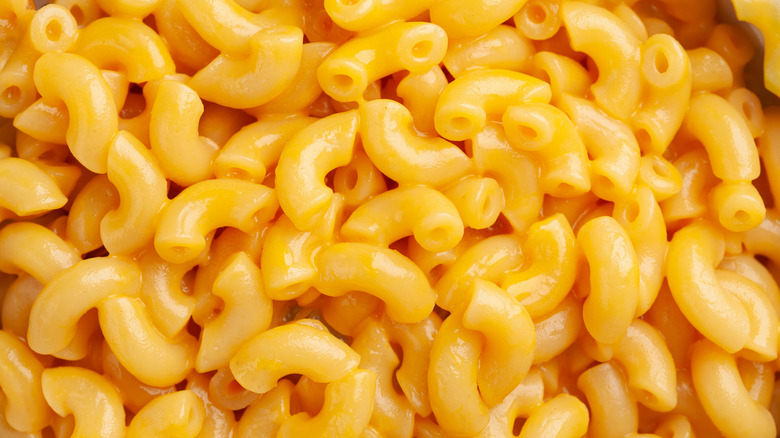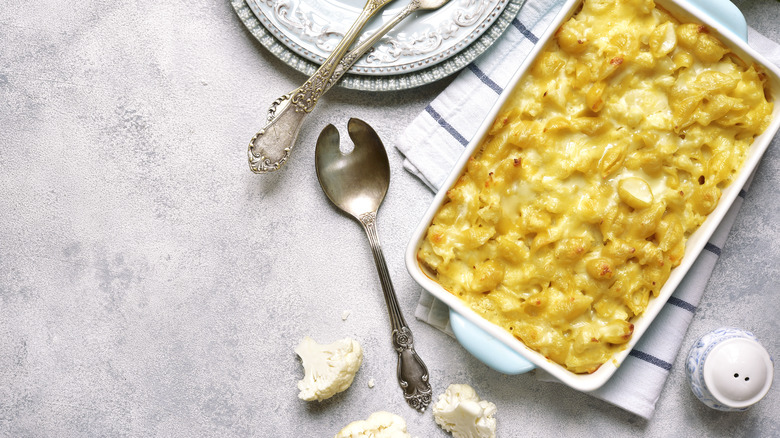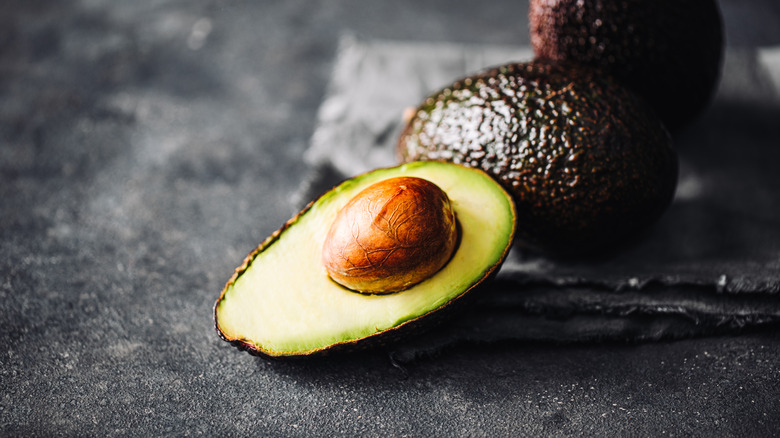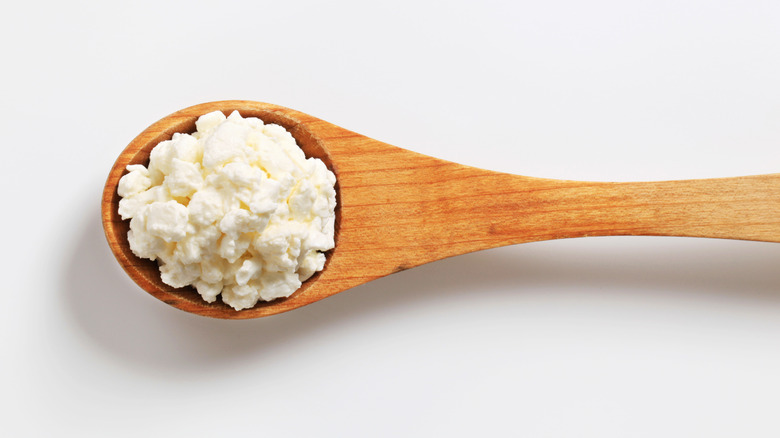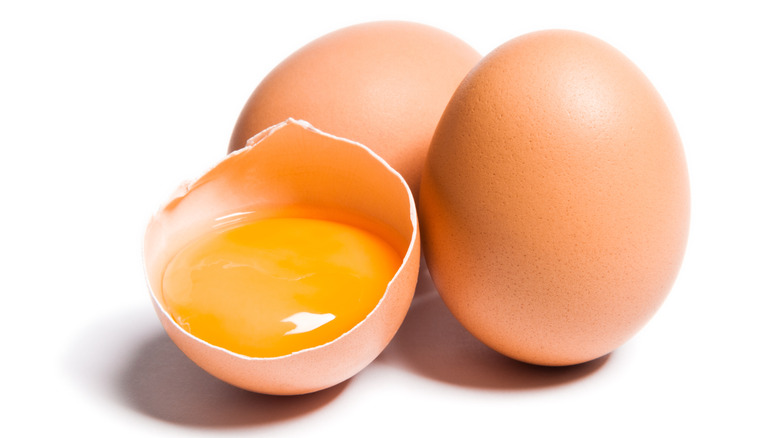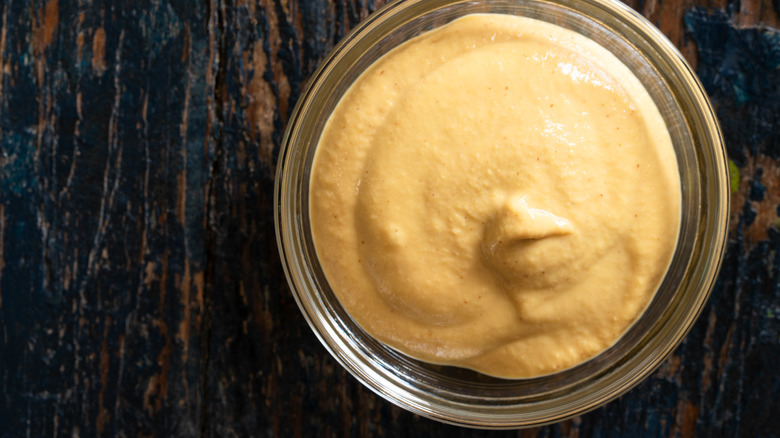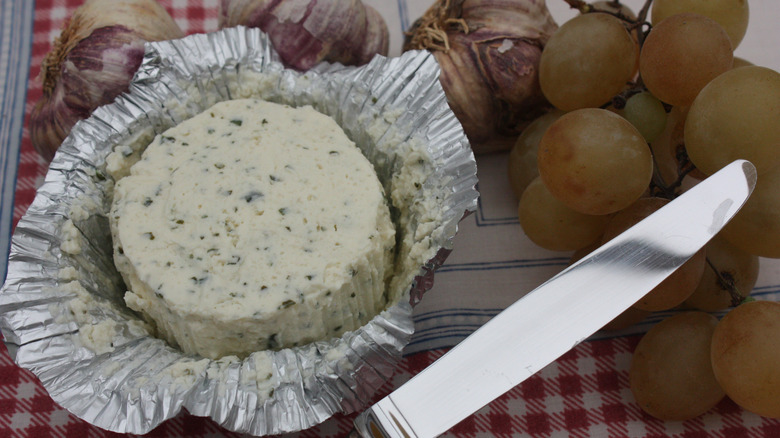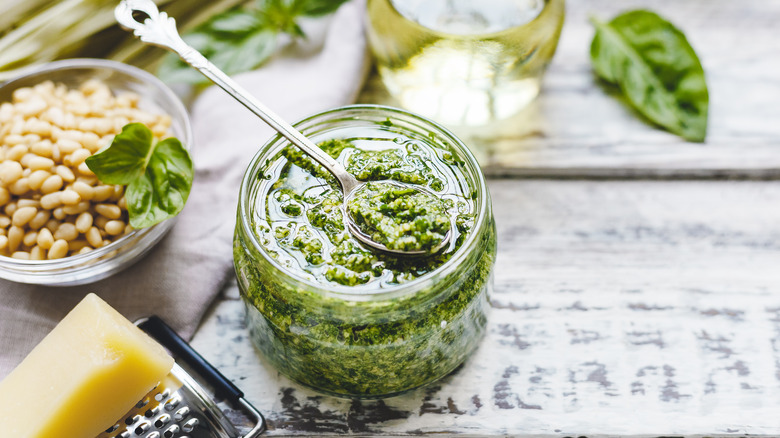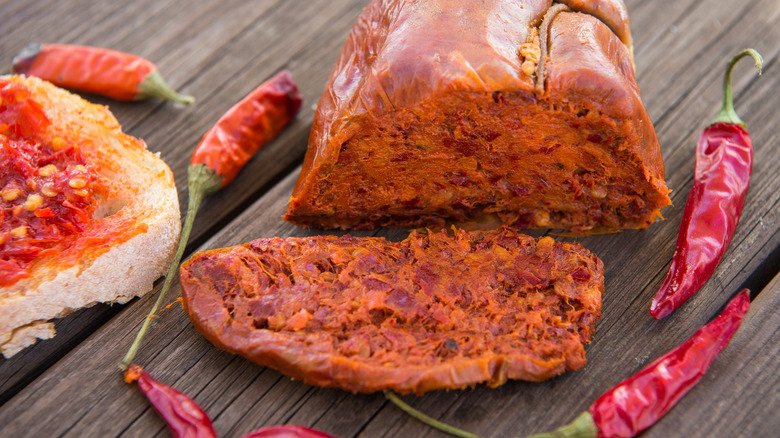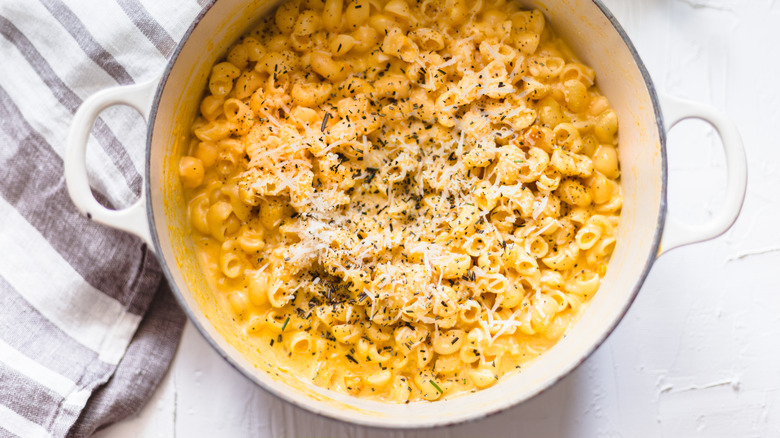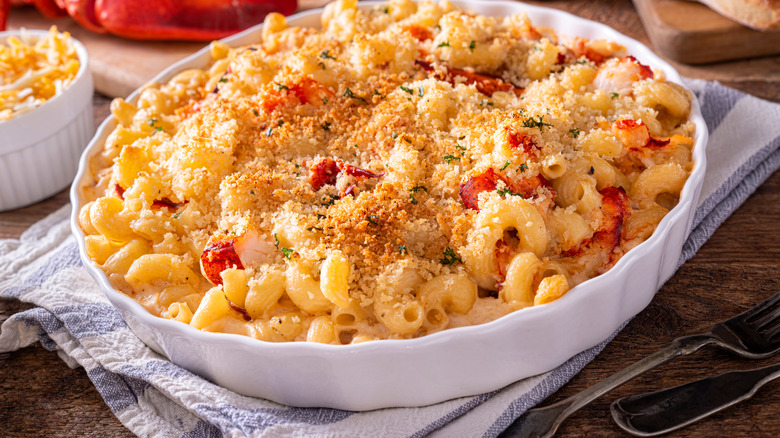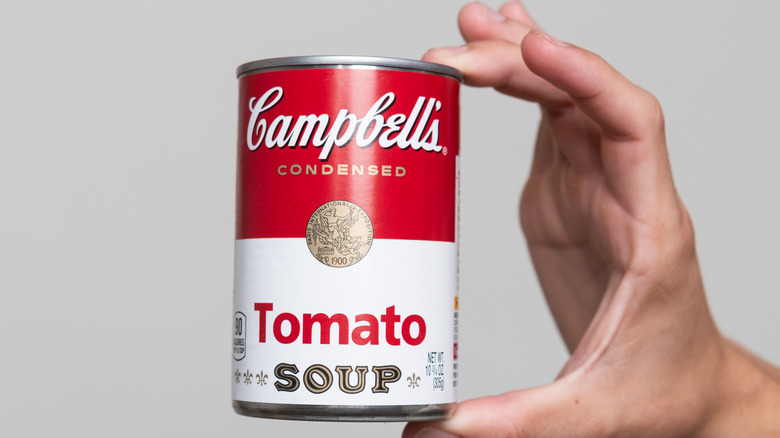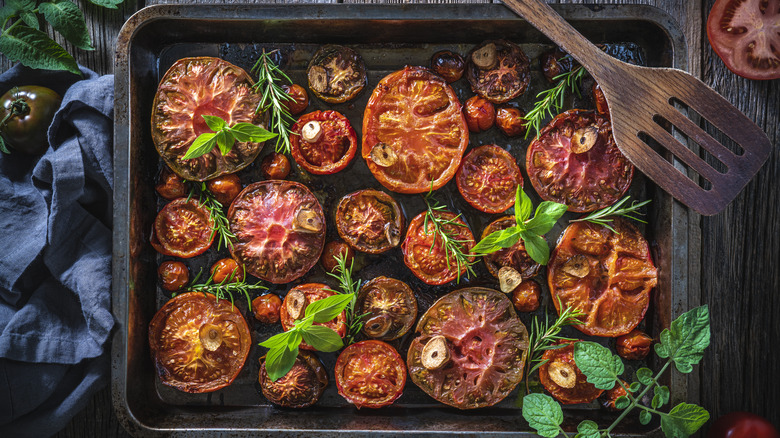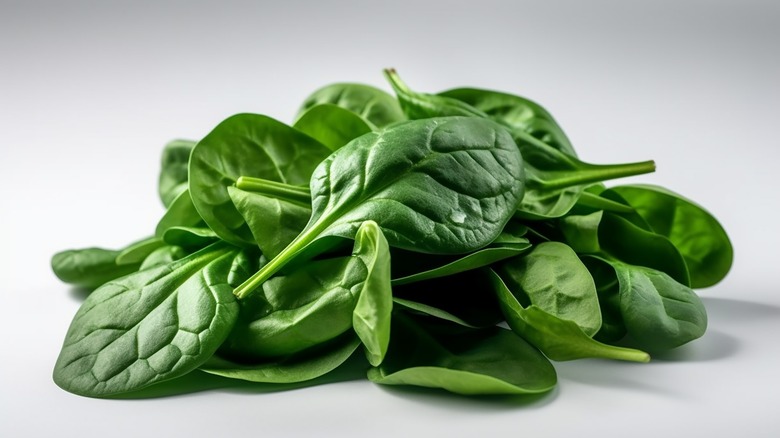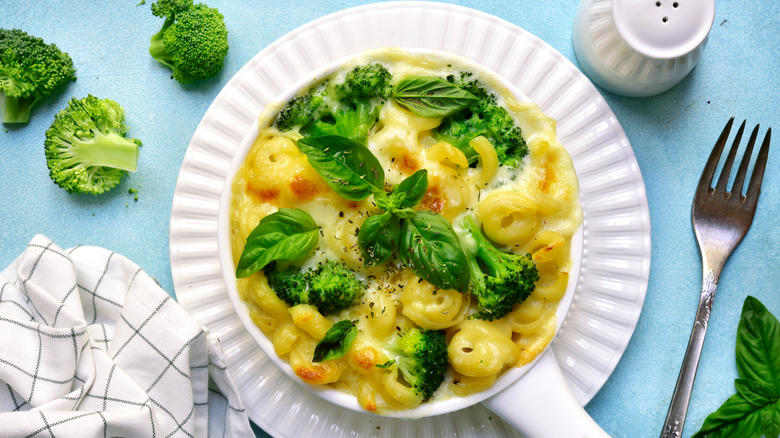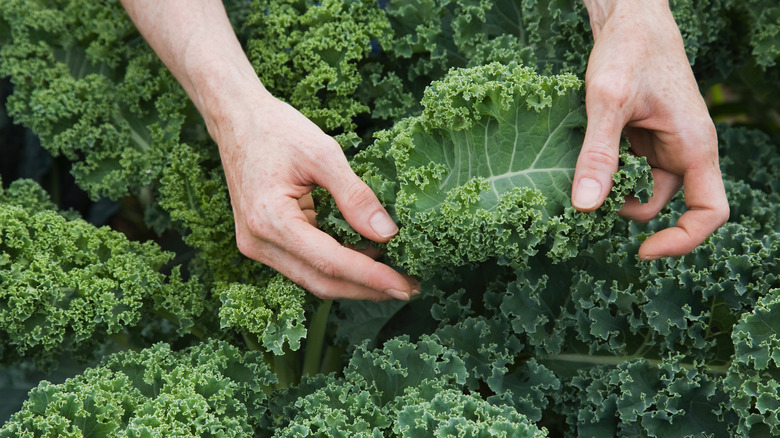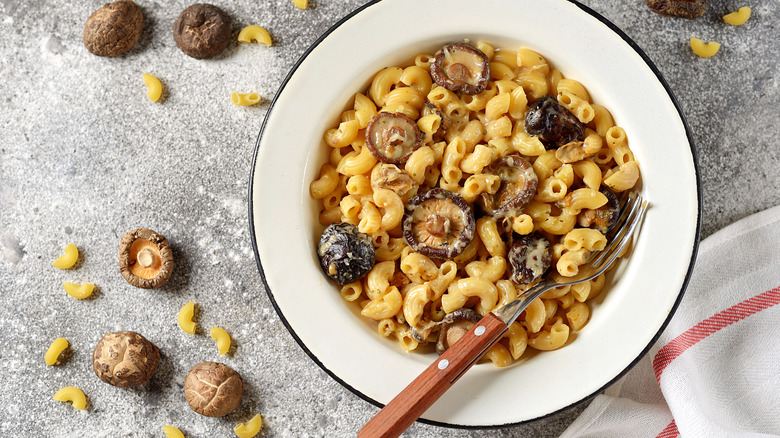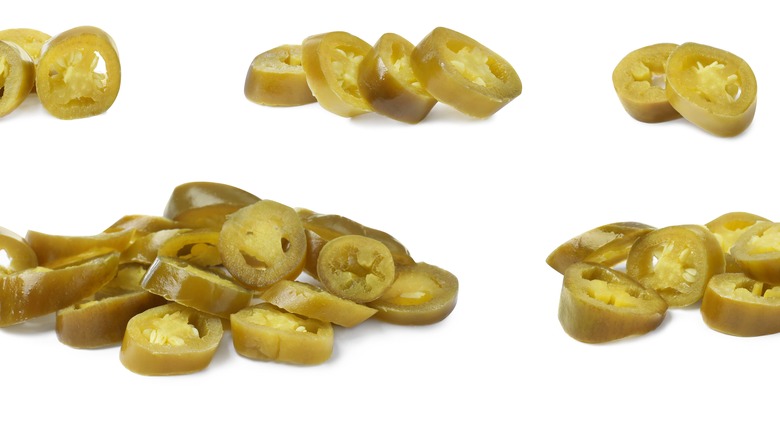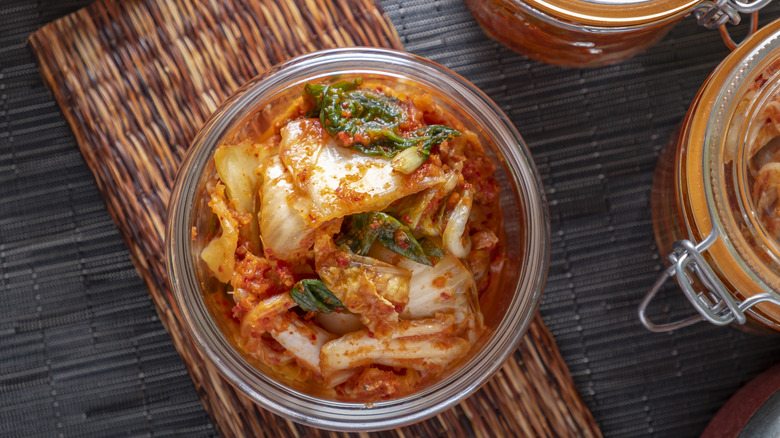19 Ingredients You Never Thought To Put In Your Mac N' Cheese
Mac and cheese is a comfort food classic for a reason. Rich and cheesy, it fulfills our common human love of rich, creamy textures, and it boasts the addictive power of casein, aka the protein found in dairy products that gives our brains a blissful hit of dopamine. But the cheese doesn't need to stand alone. There are loads of ways you can spice up mac and cheese, from bacon to breadcrumbs. And that's just the start!
For some, mixing new ingredients with mac and cheese may be based on improving the nutritional quality of the dish. After all, while cheese does indeed have some nutrients, it's also high in fat and calories. And unless you're opting for enriched macaroni, the pasta base isn't necessarily the most nutrient-dense. Add-ins like vegetables can boost the vitamin and mineral content of your mac and cheese significantly. Other add-ins may be more about changing things up with new flavors and textures: a touch of heat, a bit of vibrancy, a pop of color. And sometimes, it's a mix of all of those!
When it comes to jazzing up your mac and cheese with extra flavors, the sky's the limit. But to get the ball rolling, here are some ingredients you might want to consider using in your mac and cheese.
Cauliflower
Cauliflower has been having a moment in the past few years, appearing in everything from low-carb pizza crusts to paleo rice. So it's no wonder it's a frequent guest in mac and cheese! Rich in vitamin C, folate, and vitamin K, cauliflower also boasts loads of fiber, which makes you feel fuller longer, not to mention anti-inflammatory antioxidants including sulforaphane, a compound present in most cruciferous vegetables that some studies have shown may reduce the risk of cancer and diabetes. Plus, with its mild flavor, cauliflower is easy to blend and add to mac and cheese for body and creaminess with considerably less fat.
But cauliflower isn't just a means to render mac and cheese slightly healthier. Thanks to its mild nuttiness and toothsome texture, whole florets of cauliflower are particularly delicious when paired with cheese sauce. It's not for nothing the Brits love it so much in cauliflower cheese! When you marry this across-the-pond comfort food staple with American mac and cheese, cauliflower adds contrast, flavor, and nutrients to the dish for a triple-play winner.
Avocado
Avocado is yet another superfood that seems to be everywhere these days, from toast to smoothies. But have you ever considered it might be the perfect ingredient to add a luscious helping of healthy fats to your mac and cheese? While some consider the idea ludicrous – one recipe posted in 2015 that dared encroach on the holy sanctity of mac and cheese with avocado got a roasting online — hear us out on this one.
Avocado boasts a natural creaminess, with a mild, slightly sweet flavor that doesn't detract from the nuances of a classic mac. While adding avocado to mac and cheese on its own isn't likely to change the flavor much, when combined with other ingredients common to guacamole, like lime juice and cilantro, it lends a decidedly Southwestern flair to the typically Southern staple — particularly if you opt for pepper jack cheese in the base. Avocado can even be used to jazz up boxed mac and cheese, turning the pantry staple into something slightly more luscious (and, yes, a bit more nutritious).
Cottage cheese
Protein-rich cottage cheese became the diet food on record in the 1950s and 1960s, and while it fell from grace for a while, it has recently come back into the limelight thanks to its pleasantly sour flavor and nutrient-dense appeal. Not only is it good for you, lower in calories, and higher in protein than many other cheeses, rendering it excellent for weight loss and muscle gain, according to some experts, but cottage cheese also makes cheese sauce extra creamy without loads of extra fat — or even extra flavor.
But honestly, that's part of its charm. Cottage cheese doesn't take the spotlight away from the other cheeses in your mac and cheese. It merely boosts the creaminess quotient, so that the flavor of cheeses that might not be great melters, like Parmesan, can shine. If you want the other cheeses in your mac and cheese to do the heavy lifting in terms of flavor, cottage cheese is the perfect secret ingredient to improve texture without adding too many extra calories.
Egg yolk
If you're from the South, you probably already know that eggs are a common ingredient in baked mac and cheese to render it easily sliceable. (So says musician John Legend, who's widely shared his recipe, and so says us.) Whole eggs thicken baked mac and cheese enough to allow it to hold its shape, making it even more pleasant to serve at potlucks. (To avoid creating an unfortunate mac-and-scramble hybrid, be sure to temper the eggs in milk before mixing them with the pasta and cheese.)
But while whole eggs are a no-brainer, there's an argument in favor of adding just the egg yolk to mac and cheese, particularly the stovetop version. Divested of the proteins that give egg whites their binding power (and, for that matter, that increase the risk of your cheese sauce curdling), egg yolks lends a rich creaminess to the mac and cheese, emulsifying all of that fat into a creamy bowl of heaven.
Dijon mustard
Mustard powder is a fairly common ingredient in mac and cheese sauce, but Dijon mustard does double duty in both the flavor and texture departments. Not only does adding a touch of Dijon to mac and cheese provide a subtle balance of acidity and heat to counteract all that richness, but it also does much of the same work as the egg yolk.
Dijon mustard is a natural emulsifier, thanks to its natural richness in the compound mucilage — one of the main reasons it's such a welcome ingredient to vinaigrettes. It lends this same emulsifying power to mac and cheese, ensuring that your cheese sauce doesn't split. The resulting sauce is sure to be never oily or stringy but always and forever creamy ... not to mention delicious.
While Dijon mustard may be paired with pretty much any cheese you can think of, seeing as it originally hails from Burgundy, it's no surprise that it's particularly happy with the rich, nutty flavors of cheeses from neighboring Franche-Comté, notably Comté. This Alpine cheese is a marvelous melter with a nutty flavor not dissimilar to Gruyère, and when paired with Dijon mustard in mac and cheese, it's positively délicieux.
Boursin
If you're looking for a mac and cheese that's positively packed with flavor, look no further than Boursin. The spreadable French cheese begins with a relatively mild cow's milk cheese base. The fact that it has little flavor on its own means that it's more about the texture, a creamy vehicle for a heavy hand of garlic and herbs. Boursin is the secret ingredient that Walt Disney Parks and Resorts uses to add even more flavor and creamy texture to its mac and cheese — kind of like cream cheese on steroids that plays particularly well with a cheddar cheese base.
And what's more, if you want something less garlicky than the classic, Boursin also makes the cheese in iterations seasoned with black truffle, shallot and chive, basil and chive, cracked black pepper, caramelized onion and herb, or fig and balsamic. There are more than enough versions to test and try until you stumble upon your favorite dolled up mac recipe!
Pesto
A combination of basil, pine nuts, olive oil, and Parmesan cheese, store-bought pesto is the perfect way to add loads of extra flavor and a pop of color to mac and cheese ... without getting any garlic stank on your hands. Of course, you could make your pesto from scratch if you want to, which allows you to control not just what goes into it (basil, for instance, could be joined by peppery arugula or even iron-rich spinach, and pine nuts could be swapped out for pistachios or cashews), but also its color. Try sun-dried tomato-based pesto rosso for a totally different flavor that's equally welcome in your rich cheese sauce base.
As for how to include pesto to your mac and cheese, you can either stir it into the sauce so that it's fully integrated in the dish, or you can marble it into the casserole just before baking it, so that you end up with pesto-rich pockets throughout the bake. In keeping with the Italian theme, consider putting in chunks of mozzarella too, so that you have surprising bites of alluring cheese pull throughout!
'Nduja
Calabrian 'nduja is a spreadable spicy salami hailing from the south of Italy that's positively everywhere these days: cooked atop pizza, mixed in pasta, or stirred into mussels or bean ragouts. And that's no surprise! Unctuous and fatty, it boasts a hefty kick from Calabrian chiles and a lightly funky flavor thanks to its fermentation. Seeing as it's already heavily seasoned, 'nduja does a whole lot of work in the flavor department with very little effort — much like Boursin and pesto – making it a welcome addition to mac and cheese.
Stir 'nduja into hot mac and cheese, either on the stovetop or before baking, to infuse the dish with loads of flavor, or fold in small blobs cold from the fridge so that you get surprising bites redolent with heat and flavor lurking within the creamy base. Since 'nduja already has loads of flavor, it's best paired with cheeses that aren't too assertive. A classic cheddar base is perfect to let the 'nduja do much of the talking.
Pumpkin
Pumpkin — and winter squash in general, for that matter — is a natural pairing with mac and cheese. Not only does the orange hue of the squash lend a vibrant appeal to the cheese sauce, but the slightly sweet flavor of pumpkin also helps to offset some of the richness, leaving you with a finished dish that keeps diners coming back for more! Add to that the fact that pumpkin is rich in nutrients like beta carotene and vitamin A, and it's a no-brainer to include this fall favorite to your mac.
When including pumpkin in your mac and cheese, you can either use pumpkin purée, which will lend color to the whole dish but offer a slightly more muted pumpkin flavor, or you can roast cubes of pumpkin or another winter squash and fold them into the mac for more contrast in flavor and texture. Consider toasting some breadcrumbs with sage and thyme to sprinkle over the top for a truly autumnal iteration of this classic casserole.
Lobster
If you want your mac and cheese dressed to the nines, lobster is the perfect luxe addition to the comfort food classic. The sweetness of lobster pairs nicely with the creamy, umami-rich cheese sauce, and it definitely brings special occasion flair to the dish. Most recipes call for folding just-cooked chunks of lobster into your pasta before baking it as a casserole, though you'll want to be careful not to overcook the lobster, lest it become chewy and rubbery. To reduce this risk — and, for that matter, to make the serving vessel just as exciting as what's inside — consider a stovetop version.
First, steam the lobster and remove it from its shell, taking care to leave the shell of the tail intact. Cut the lobster into chunks, and blanch and clean the shells, and set both aside. Next, make the mac and cheese with white cheddar, and sauté some breadcrumbs in butter and Old Bay Seasoning. Finally, fold the lobster chunks into the stovetop mac and cheese, and pile it into the lobster shells. Sprinkle with the breadcrumbs, and get ready to dig into a restaurant-quality mac and cheese.
Tomato soup
A classic pairing with grilled cheese, tomato soup is also a welcome addition to your mac and cheese. Umami-rich tomato highlights the savoriness of cheese, bringing a touch of sweetness and welcome acidity, not to mention even more creaminess. (As though mac and cheese were lacking in the texture department!) And while this is certainly a great way to use up any leftover homemade tomato soup (or, for that matter, homemade marinara sauce), a good old can of condensed tomato soup is a reliable pantry staple that will truly transform the dish and take it to the next level.
If you want to include even more nostalgic flair to a tomato soup mac and cheese, consider topping it not with breadcrumbs, but rather with crushed Cheez-Its before baking. The resulting mac and cheese will certainly send you down memory lane, and given its reliance on pantry staples, it is the perfect midweek meal when you're low on ideas.
Roasted tomatoes
Soup isn't the only way you can add the rich, tangy, slightly sweet flavor of tomatoes to your mac and cheese. Roasted tomatoes give mac and cheese a delicious glow-up, with pockets of sweet, caramelized flavor hidden among the noodles.
To try this at home, simply roast quartered tomatoes in the oven for about half an hour, seasoning them ahead of time with salt, pepper, garlic, and the herbs of your choosing. Then fold the cooked tomatoes into your mac and cheese, reserving a few to dot over the top of the casserole for a pretty pop of color. You could also use cherry tomatoes, which cook up quickly in the air fryer. In just 15 minutes, these pretty tomato jewels are ready to enjoy — choose a mix of colors for an even prettier final result.
If even 15 minutes seems too long to wait, you could also opt for sun-dried tomatoes in a pinch. Just be sure to chop them into smaller pieces first, as these tomatoes pack even more flavor than roasted ones and could overpower the mac and cheese if left whole.
Spinach
Adding vegetables to your mac and cheese is a great way to bulk it out and gain a heaping helping of nutrients. And while many different vegetables could go nicely with the flavors of mac and cheese, spinach is a no-brainer. Rich in carotenoids, which your body transforms to vitamin A, spinach is also rich in vitamin K1, folic acid, iron, and calcium. Plus, its earthy flavor goes wonderfully with slightly more assertive, acidic cheeses like feta or goat cheese.
Think of this one-pot spinach and feta mac and cheese recipe a bit like what would happen if mac met Greek spanakopita, with a moreish combo of classic cheddar and funky feta. Or jazz up a classic mac and cheese by folding in wilted spinach and hunks of creamy chèvre. The resulting mac and cheese will be beautiful with its bright green color — a casserole Popeye the sailor man would love!
Broccoli
Broccoli and cheese sauce are a match made in heaven, so it's no surprise that broccoli is a welcome addition to mac and cheese. Of course, there's nothing worse than overcooked, gray broccoli. (Mac and cheese that smells like wet cabbage? No thanks!) To keep this from happening with a baked mac and cheese, the secret is to put the broccoli florets to the pasta mixture raw so that they don't overcook while the casserole bakes. If you're making a stovetop version, meanwhile, roast or sauté your broccoli separately, and fold it into the mac and cheese just before serving.
Broccoli isn't just a delicious boost to mac and cheese, thanks to its earthy nuttiness and slight sweetness. It's also chock-a-block with vitamins, minerals, and fiber, not to mention antioxidants like cancer-fighting sulforaphane, and flavonoids like anti-inflammatory kaempferol, transforming mac and cheese into a veritable superfood. Consider including broccoli, cauliflower, and pretty romanesco florets to your mac and cheese for complementary flavors and nutrients, not to mention a beautiful color contrast in the finished pasta bake.
Kale
Kale is yet another superfood that makes a surprisingly delicious mac and cheese. The texture of kale makes it an easy add-in: tender enough to wilt down quickly in the cheese sauce but robust enough to remain present and toothsome in the final dish. And of course, kale has loads of benefits, a true "nutrition superstar," according to the Mayo Clinic, thanks to its off-the-charts richness in vitamins, folate, fiber, and manganese.
While curly green kale has become a bit of a standard, there are other varieties to choose from too. Purple kale is a touch less bitter than green, plus it brings an even more vibrant color to mac and cheese. Lacinato kale, also known as cavolo nero or dinosaur kale for its unique texture, has an even sweeter flavor that might be more palatable for little ones — or indeed anyone who's not a fan of overly bitter flavors.
Mushrooms
Many cheeses have a slight mushroomy funk, especially members of the bloomy-rinded family like Brie and Camembert. These white-rinded cheeses are inoculated with a specific sort of fungus (a miniature mushroom, if you like), and their flavor is only highlighted and magnified when paired with mushrooms.
Since mushrooms are full of water, it's important to sauté them before adding them to your mac and cheese. Cut whichever mushrooms you plan to use into bite-sized pieces before cooking them in a mix of olive oil and butter in a pan set over medium-high heat. Season the mushrooms with salt — and, if you like, garlic and fresh herbs like thyme — before folding them into your mac and cheese. You could also use rehydrated dried mushrooms like porcinis or morels.
A basic cheddar sauce is a lovely option for a mushroom mac and cheese, and Gruyère punches things up to 11. But whichever base cheese you choose, consider folding in a few chunks of Brie or Camembert for cheesy pockets that will mirror those lovely mushroomy flavors.
Chili crisp
One delicious way to cut through the richness of mac and cheese is with a bit of heat. (It's not for nothing that so many mac and cheese recipes call for a pinch of cayenne or mustard powder!) But if you want to make your dish extra delicious, consider serving your mac and cheese with a side of chili crisp.
Lao gan ma is one of the most popular Chinese hot sauces, known for its crispy texture and rich flavor. If it's so beloved, it's probably because it doesn't just pack heat. With garlic, onion, sesame, and shallot, it marries sweet, savory, and umami flavors for a total whammy of a sauce. You can easily find chili crisp in stores these days, but it's also super easy to make at home, which allows you to dial up (or down) the heat to your perfect level. Rather than stir this sauce into your mac and cheese, serve it on the side so that everyone can dress up their portion as hot — or not — as they like.
Chiles
Yet another way to bring a bit of heat to your mac and cheese is by inviting chiles to the party. A can of diced green chiles is an easy add-in, lending a moderate kick and a nice pop of color to your mac in the time it takes to open the pantry and pop the can lid. Pickled jalapeños offer slightly more heat, not to mention a welcome bit of briny acidity to cut through all that richness.
Since you're already putting some spice in your mac and cheese, you can pump things up even further by seasoning the base with cayenne pepper and opting for a chile-studded cheese like pepper jack. Set the Tabasco on the table for chile heads who want even more spice. And don't worry about the chiles overpowering the casserole: Given the creamy richness of mac and cheese, it can more than take the heat.
Kimchi
Kimchi is a funky fermented cabbage from Korea that's recently become particularly popular in foodie circles. It's lovely when paired with fattier dishes like stewed pork, as in a classic Korean kimchi jigae, or even fried chicken, where it can do double-duty seasoning the brine and serving as a condiment.
It's perhaps no surprise, then, that it's a welcome addition to mac and cheese: The funkiness of both the fermented cabbage and the fermented milk talk to each other wonderfully, and a touch of gochujang, a Korean chile paste, brings a bit more heat and a welcome note of sweetness to balance everything out.
Including kimchi with mac and cheese isn't just a delicious choice; it's also a nutritious one. Kimchi is known for its wealth of health benefits, namely nutrients like vitamin K and riboflavin thanks to the cabbage base, plus a host of gut-healthy probiotics thanks to the lacto-fermentation process. Adding it to mac and cheese makes for a perfect pairing.
